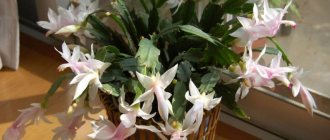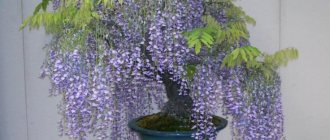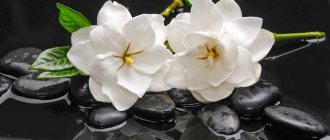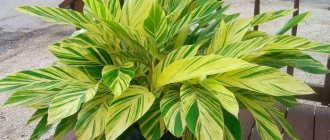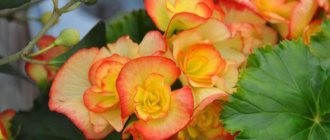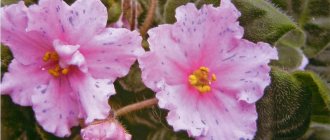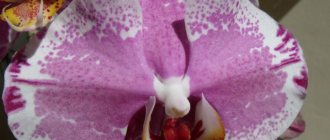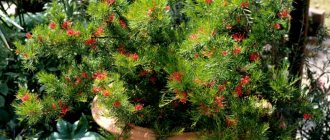Skimmia is an evergreen plant belonging to the Rutaceae family. Under natural conditions, the shrub grows in Asia and Japan. In regions with cold climates, gardeners grow it as an ornamental houseplant and are highly valued for its attractive appearance, which the plant retains throughout the year. In spring and summer, the bush is covered with beautiful inflorescences of small flowers, and in autumn and winter red berries ripen on it.
Description
Skimmia is a perennial plant with a spherical crown. The shrub most often grows no more than 1 meter in height. The leaves on short petioles are oblong, hard, slightly reminiscent of a bay leaf. The edges of the leaves sometimes have a narrow border of light green or red. They are dark green above and light green below. On the back of the leaves there are special glands that emit a pleasant aroma when the bush blooms.
Skimmia is a dioecious plant (there are male and female varieties of bushes in the genus). The inflorescences are paniculate, blooming at the ends of branched shoots. The flowers are shaped like a five-pointed star. Their color can vary: from white to purple. Flower size is 1-2 centimeters. Flowering time is March-June.
After flowering, round red drupes appear in place of the flowers. They can stay on skimmia bushes for a very long time. Sometimes it even happens that the plant is already blooming again, and last year’s dried berries are still showing off next to the flowers.
Botanical description of the plant (with photo)
When compiling a botanical description of skimmia, most botanists focus on the two most popular species of this plant - Japanese (Skimmia Japonica) and Reeves' variety. Although many other botanical species are known in nature. Due to its popularity as a garden and house plant, a large number of hybrids have recently appeared.
They belong to the Rutaceae family. The genus is represented by dome-shaped or spherical bushes. They develop quietly and branch well. In its natural environment, the shrub easily grows up to 7 meters in height in a few years. In artificially created conditions, an evergreen perennial can reach a maximum height of 150 cm.
The root system is branched. In general, this plant is considered a rhizomatous plant. Young root shoots tend to become woody over time. The shoots are dense, with medium branching. The leaf blades are very similar to Laurel leaves. One bush can have plates from 5 to 20 cm in length. They are hard to the touch. The upper part is painted dark green, the underside is slightly gray. In some varieties, the leaf blades may have a creamy yellow or burgundy edge.
At the end of spring, Japanese skimmia begins to bloom. At this time, small flowers are formed, emitting a pleasant aroma. By the way, approximately the same smell can be felt when rubbing a leaf. At its base there are glands that produce a secretion with a special aroma.
After flowering, usually closer to autumn, the fruits begin to ripen. The type is a drupe (a berry with one large seed). Whether in gardens or at home, they can stay on the bush until the next gardening season. Thanks to its red berries and resemblance to holly, Japanese skimmia is often given as a Christmas gift to family and friends on Christmas Eve.
Look at the Japanese skimmia in the photo, which shows adult specimens in different types of formation using pruning:
Reproduction methods
Propagation of skimmia is possible in two ways:
- cuttings;
- seeds.
Cuttings are best carried out between August and February. For rooting, apical semi-lignified shoots are chosen. The length of the cuttings should be approximately 8-12 centimeters. The two bottom leaves are cut off from them. For better rooting, the branches are treated with a drug - a root formation stimulator. Then, the cuttings are placed in soil made from a mixture of peat and sand. The containers are covered with film and kept in a well-lit room.
Rooting will take approximately 15-20 days, provided that the air temperature is maintained at about 22 degrees. A sign that the plant has taken root will be the active growth of new shoots.
Skimmia seeds should be stratified before planting. To do this, they are sent to the refrigerator for 7-10 days. Then, sow the material to a depth of 1-2 cm in a mixture of peat and sand. The pots are placed in a bright place with an air temperature of 22 degrees. The first shoots appear after 2-3 weeks. Plants are transplanted into individual pots when they have formed 4 true leaves.
Conditions of detention
Temperature conditions. The optimal temperature range is from 18 to 24 ° C. At higher temperatures, it is necessary to increase watering and air humidity. At temperatures below 12 ° C, plants slow down their growth and enter a dormant period, in which they remain throughout the winter.
Lighting. A well-lit place without direct sunlight. The pot with the plant must be turned about ¼ turn every week so that the skimmia develops symmetrically.
Skimmia care at home. As growth begins, prune shoots that are too tall or weak to encourage lateral shoots to appear. By pruning, the plant can be given a beautiful rounded shape. Skimmia can be placed outdoors during the summer. Remember that all plants should be moved gradually so that they get used to the new living conditions.
Substrate. Skimmia requires nutritious soil with a high organic content and good drainage. The soil may consist of peat, leaf mulch, perlite or vermiculite to improve drainage and have a slightly acidic pH.
Feeding. Every 2 weeks in spring and summer. In the fall, feeding is stopped and resumed only with the beginning of new growth, in the spring.
Purpose.
Flowering time. April.
Air humidity. If the indoor air becomes too dry or the temperature is high, increase the humidity using a room humidifier or by placing the plant on a tray with damp pebbles. Make sure that the water in the tray does not touch the bottom of the plant pot. You can spray the leaves with water at room temperature. Skimmies like well-ventilated areas with a constant flow of fresh air, but without cold drafts.
Soil moisture. The soil should be evenly moist, but not waterlogged. Between waterings, the top layer, 3-5 cm thick, is slightly dried. In autumn, the frequency of watering is slightly reduced. For irrigation, it is advisable to use softened water at room temperature.
Transfer. Young plants are replanted annually - as they grow - into larger pots. Adult plants need to be replanted every 2 - 3 years. For large tub plants, simply change the top layer of soil to fresh one every year
When planting, it is important to maintain such a depth that the grafting is at ground level. If the skimmia is deeply buried in the ground, it will not bloom.
Reproduction. Stem cuttings about 10 cm long, in spring and summer, using growth hormones. Rooting is carried out under cover made of a transparent plastic cap or glass for 6 - 8 weeks. Seeds sown in spring.
Pests and diseases. Red spider mites. Mealybugs prefer young trees. Whiteflies hide on the undersides of leaves, sucking out the sap. Aphids cause leaves to curl and become crinkled. Foliage can get burned if exposed to direct sunlight for long periods of time. Skimmia grows slowly and young leaves are smaller in size due to a lack of nutrients in the soil. Fungal diseases occur when there is insufficient drainage and maintenance in waterlogged soil.
Note. With proper care, skimmia can grow successfully in indoor culture for many years.
The plant is replanted when the roots become crowded in the flower container. Select a pot that is not too spacious, at the bottom of which a layer of drainage 2-3 cm thick made of washed pebbles or expanded clay is placed. The composition of the soil mixture is as follows:
- peat;
- leaf humus;
- clayey chernozem;
- coarse sand.
Important!
Skimmia does not tolerate lime in the substrate; only acidic soil mixtures are suitable for its cultivation. When planting a shrub, the root collar is not buried in the soil, but left open, otherwise the plant refuses to grow and begins to gradually wither.
The plant is not picky about caring for it; it is enough to choose a dimly lit place in the apartment so that direct sunlight does not fall on the leaves, causing burns, and there is enough light so that the branches do not stretch unnaturally.
The room temperature needs to be moderate; skimmia does not like heat. If the thermometer rises to 30 degrees, the shrub is sprayed and the room is regularly ventilated. In summer, pots with plants are taken out into the garden or planted in open ground; in winter, they try to keep them in a low-heated place with an air temperature of 8-10 degrees above zero.
Water frequently, but with a very small amount of soft, chlorine-free water. Skimmia does not need additional air humidity, but bathing is allowed periodically to wash off dust from the leaves.
From April to September, the plant is fertilized twice or thrice a month with complex mineral fertilizers for beautiful flowering plants.
There is no need to form a crown; it already grows compactly, without additional pinching; only pruning of faded shoots and flower stalks on male plants is allowed.
In regions with warm winters, skimmia are left to overwinter in open ground.
Crops with decorative foliage develop well and increase green mass in bright light (but not in direct sun), so a place with bright but diffuse lighting is suitable for skimmia so that the leaves do not get burned. In partial shade or in artificial light, the bush does not look so decorative - fewer leaves are formed.
In winter, during the dormant period, the shrub should be kept in a cool room (5-10 C°) with dry air, and in the summer, during the active growing season, it should be taken out into the fresh air in the garden, on the balcony, on the terrace. The optimal temperature in summer is 18-24 °C. If the temperature is constantly high, the plant may shed leaves, buds, and flowers.
A period of rest is necessary for skimmia - the formation of flower buds occurs.
The soil should be moist (not wet), drained so that moisture does not stagnate around the roots, rich in humus, with a pH of 3.0-5.5 (acidic environment) - interveinal chlorosis develops in a slightly acidic environment. You can prepare the soil mixture yourself by mixing humus, leaf soil, peat and sand in a ratio of 1:1:2:1, or purchase soil for azaleas, camellias, gardenias, rhododendrons, which also love acidic soil.
Growing and care
Like any other indoor plant, skimmia bushes need proper regular care.
Watering
The plant can grow and develop well in a city apartment with insufficient air humidity. However, it needs regular watering. This is especially important in spring and summer. The soil in the pot should not dry out during this period, as the skimmia is actively growing and blooming. In the autumn-winter period, the frequency of watering is reduced.
Top dressing
From the beginning of spring to the onset of autumn (April - September), skimmia needs to be fertilized 2 times a month with a composition intended for flowering plants.
Lighting
Skimmia grows well in areas with plenty of light. But, you need to take into account that direct sunlight is harmful to it. They can leave burns on the leaves.
Decorative properties of Japanese skimmia and application ideas
Skimmia is the perfect transition plant between the reds and oranges of early fall and the approaching December holidays. Highlighted along with other autumn plants such as heather and ivy, to complement the display with some home accessories that are in keeping with the season, this could be lanterns, a pair of wellies or a rake.
Since Skimmia is a popular front door plant (placed on either side of the door), a symmetrical display of the plants already placed in an attractive pot or zinc bucket is a good idea.
Its medium texture blends into the landscape but can be balanced by one or two finer or coarser trees or shrubs for effective composition.
Japanese skimmia is often planted in a group where it forms a low-growing hedge, as is the case with boxwood or English yew. It is an ideal plant under tall trees or shrubs or along shady paths.
Try not to plant it too close to the concrete foundation of your home, as the higher soil pH near these areas can harm plant growth.
Kinds
There are 12 species of this shrub in total. But, in decorative floriculture, various varieties of Japanese skimmia and some others are most often used.
Skimmia japonica
In nature, a bush of this species can grow up to 1-1.5 meters. This is a dioecious plant. Based on it, breeders have developed several hybrids:
- Rubella is a male hybrid. The bush is compact, the leaves are dark green with a red edge.
- Foremanii is a female hybrid. Forms large beautiful clusters of berries after flowering.
- Fructo Alba - differs from other hybrids in the color of the berries. They are completely white.
- Magic Merlot has small leaves. Inflorescences are shaped like silver balls.
- Smits Spider. The berries on this hybrid become the color of mango by autumn.
- Fragrans are the male variety. The color of the inflorescences is white. The aroma is reminiscent of lily of the valley.
- Skimmia reevesiana (Reeves) is a self-pollinating plant. Its white inflorescences contain both male and female flowers. The berries are slightly oblong, raspberry in color.
- Brocox Rocket. On the large spherical inflorescences of this hybrid, the flowers are initially green. By autumn they gradually turn white.
Skimmia laurel
The berries of this type of shrub are colored black. The leaves are elongated, lanceolate. The inflorescences are spherical and consist of small greenish flowers. Grows in heights up to 90 cm.
Skimmia doubtful
This is a male bush. In nature it grows up to 3 meters in height. The crown can reach 1.5 meters in width. The inflorescences are spherical and cream-colored. During flowering it emits a strong pleasant smell.
Skimmia repens
The bush is cylindrical in shape. Its branches do not have leaves at the base. The dense inflorescences consist of unusual white triangular flowers. In autumn, rather large red berries ripen in their place.
Types and varieties of skimmia with photos and names
Skimmia japonica
Dioecious shrub reaching a height of 1 meter. In order for the plant to begin to bear fruit, the male and female species are placed side by side. The male and female flowers begin to bloom in March-April and resemble small stars in appearance. In autumn, shiny red fruits are already formed.
The most popular varieties of Japanese skimmia:
- "Rubella" has purple leaves, dark red buds and white male flowers with bright yellow anthers.
- “Foremani” - this variety is a female hybrid that bears fruit in bright, large clusters.
- "Magic Merlot" - the plant has variegated thin leaves with numerous yellow stripes. Produces bronze buds and beige flowers.
- “Fructo Alba” bears white berries.
- "Fragrens" - during flowering, the flowers exude a delicate aroma of lilies of the valley.
- 'Smith's Spider' - Produces soft green buds in the spring that bloom into flowers tinged with mango fruit.
- "Brocox Rocket" - blooms with large round inflorescences of green flowers.
Diseases, insect pests
All types of skimmia are resistant to fungal infections, but with constant waterlogging, the roots begin to rot, which can lead to the death of the plant. You can save it by replanting it in new soil - remove the bush from the pot, free the roots from the old soil, cut off the affected areas, and treat the cuts with charcoal powder.
If there are irregularities in care (too dry air, overdried soil or, conversely, low temperature combined with waterlogging), insects that feed on the juice of young leaves can colonize the bush: spider mites, scale insects, mealybugs.
You can notice a spider mite by a sticky thin web in the leaf axils, on the underside of the leaf, on flowers; the mealybug leaves behind a gray-white coating resembling cotton wool; a sticky sugary coating appears in place of the aphid colonies. Insects and their larvae, sucking out the juices, deprive the plant of nutrients, as a result the leaves become deformed, turn yellow and dry out, the flowers shed their petals, wither, and the buds fall off without blooming.
At the initial stage of infection, while there are not very many insects, you can do without insecticides, but if the colonies have occupied a large area, then chemical agents (Aktellik, Fitoverm, Fufanon) are used. First, the leaves and stems are wiped with a sponge soaked in a soap solution (it is better to use laundry soap), removing insects mechanically, then the entire bush is washed under the shower, directing the stream to the stems.
Varieties of Japanese skimmia
There are several cultivators of Japanese skimmia, some of whom have been awarded the Royal Horticultural Society's Award of Lifetime Achievement in the Garden. Most of these varieties are either male or female, but there are some varieties that are also hermaphroditic, self-fertilizing varieties.
- Japanese skimmia Fragrans (male)
- Japanese skimmia Nyman (female)
- Japanese Skimmia Rivesiana (self-fertile)
- Japanese skimmia Temptation (self-fertile)
- Japanese Skimmia Rubella (male)
- Japanese Skimmia Veitchii (female)




